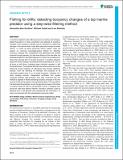Files in this item
Fishing for drifts : detecting buoyancy changes of a top marine predator using a step-wise filtering method
Item metadata
| dc.contributor.author | Gordine, Samantha Alex | |
| dc.contributor.author | Fedak, Mike | |
| dc.contributor.author | Boehme, Lars | |
| dc.date.accessioned | 2015-12-22T15:40:03Z | |
| dc.date.available | 2015-12-22T15:40:03Z | |
| dc.date.issued | 2015-12-02 | |
| dc.identifier | 173812742 | |
| dc.identifier | 33f3e6f1-867e-4b92-ac12-4bf069552d3a | |
| dc.identifier | 84962909327 | |
| dc.identifier | 000365754900020 | |
| dc.identifier.citation | Gordine , S A , Fedak , M & Boehme , L 2015 , ' Fishing for drifts : detecting buoyancy changes of a top marine predator using a step-wise filtering method ' , Journal of Experimental Biology , vol. 218 , no. 23 , pp. 3816-3824 . https://doi.org/10.1242/jeb.118109 | en |
| dc.identifier.issn | 0022-0949 | |
| dc.identifier.other | ORCID: /0000-0002-9569-1128/work/47136243 | |
| dc.identifier.uri | https://hdl.handle.net/10023/7923 | |
| dc.description | This research was partly funded by a Natural Environment Research Council grant [NE/E018289/1]. Further, a PhD studentship in Marine Biology partially funded by the Natural Environment Research Council [NE/L501852/1] and the University of St Andrews 600th Scholarship supported this work. | en |
| dc.description.abstract | In southern elephant seals (Mirounga leonina), fasting and foraging related fluctuations in body composition are reflected by buoyancy changes which can be monitored by changes in drift rate. Here, we present an improved knowledge-based method for detecting buoyancy changes from compressed and abstracted dive profiles received through telemetry. We applied this step-wise filtering method to the dive records of 11 southern elephant seals, which identified 0.8% to 2.2% of all dives as drift dives. At the beginning of the migration, all individuals were strongly negatively buoyant. Over the following 75 to 150 days, the buoyancy reached a peak close to or at neutral buoyancy, indicative of a seal’s foraging success. Ground-truthing confirmed that this new knowledge-based method is capable to reliably detect buoyancy changes in the dive records of drift diving species using abstracted dive profiles. This affirms that the abstraction algorithm conveys sufficient detail of the geometric shape of drift dives for them to be identified. It also suggest that using this step-wise filtering method, buoyancy changes could be detected even in old datasets with compressed dive information, for which conventional drift dive classification previously failed. | |
| dc.format.extent | 535780 | |
| dc.language.iso | eng | |
| dc.relation.ispartof | Journal of Experimental Biology | en |
| dc.subject | Buoyancy | en |
| dc.subject | Marine mammal | en |
| dc.subject | Elephant seal | en |
| dc.subject | Body composition | en |
| dc.subject | Drift diving | en |
| dc.subject | Telemetry | en |
| dc.subject | Foraging ecology | en |
| dc.subject | Diving behaviour | en |
| dc.subject | QH301 Biology | en |
| dc.subject | GC Oceanography | en |
| dc.subject | NDAS | en |
| dc.subject | SDG 14 - Life Below Water | en |
| dc.subject.lcc | QH301 | en |
| dc.subject.lcc | GC | en |
| dc.title | Fishing for drifts : detecting buoyancy changes of a top marine predator using a step-wise filtering method | en |
| dc.type | Journal article | en |
| dc.contributor.sponsor | NERC | en |
| dc.contributor.sponsor | NERC | en |
| dc.contributor.sponsor | NERC | en |
| dc.contributor.institution | University of St Andrews. School of Biology | en |
| dc.contributor.institution | University of St Andrews. Sea Mammal Research Unit | en |
| dc.contributor.institution | University of St Andrews. Marine Alliance for Science & Technology Scotland | en |
| dc.contributor.institution | University of St Andrews. Scottish Oceans Institute | en |
| dc.identifier.doi | 10.1242/jeb.118109 | |
| dc.description.status | Peer reviewed | en |
| dc.identifier.url | http://www.smru.st-andrews.ac.uk/Instrumentation/Overview/ | en |
| dc.identifier.grantnumber | NE/E018289/1 | en |
| dc.identifier.grantnumber | en | |
| dc.identifier.grantnumber | NE/J005649/1 | en |
This item appears in the following Collection(s)
Items in the St Andrews Research Repository are protected by copyright, with all rights reserved, unless otherwise indicated.

